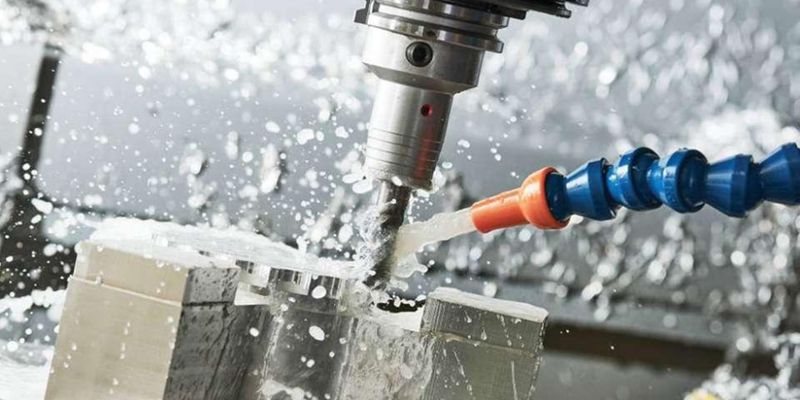- July 28, 2023
Machinists often utilize CNC machine coolant to mitigate the effects of overheating on the cutting tool or materials during the CNC machining process. These coolants are effective as lubricants and cooling mechanisms and aid chip removal.
This article discusses how CNC coolant works, and its delivery technique. You will also learn about the importance of coolants in a CNC machine, types, and more. Let’s get to it!
What Is CNC Coolant?
CNC coolant or cutting fluid is an industrial fluid commonly used in metal cutting operations for improved efficiency. CNC vowin.cn/en/News/news1251.html' target='_blank'>machining coolant comprises special chemical additives formulated through scientific compound concentration. Its primary elements include animal fat, water, petroleum distillate, vegetable oil, and other raw materials.
These coolants improve the CNC machines’ capability to cut materials such as high-density plastics, fiberglass, and metals while reducing high-temperature build-up.
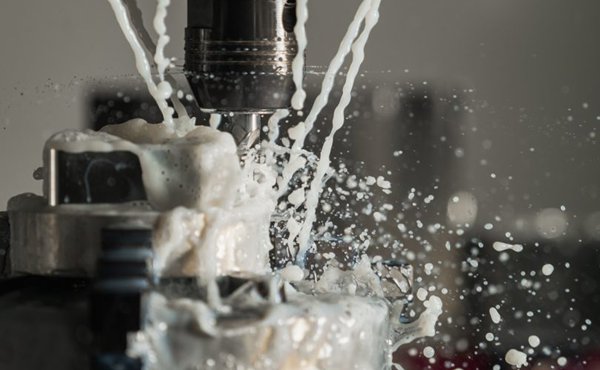
How Do Coolant Systems Work?
A CNC machine coolant mixture flows over the work area during the CNC machining operations. The coolant washes chips and particles from the work area like a flood. Then it flows into the sump at the machine’s bottom, where you must pump and recirculate it to the work area for continuous use.
The coolant cools the workpiece when machining at high speeds and lubricates the cutting tool at low speeds. Therefore, the CNC coolant increases the cutting tool’s lifespan by protecting it from corrosion and safeguarding the workpiece from deformation. To ensure peak performance, you must monitor, maintain, and adjust central and single CNC machine coolant systems.
However, a small coolant system uses a less effective component for its oil separation and filtration, resulting in consistent changes and greater variation in concentration levels. So, using coolants less susceptible to contamination from shavings in small systems would be best.
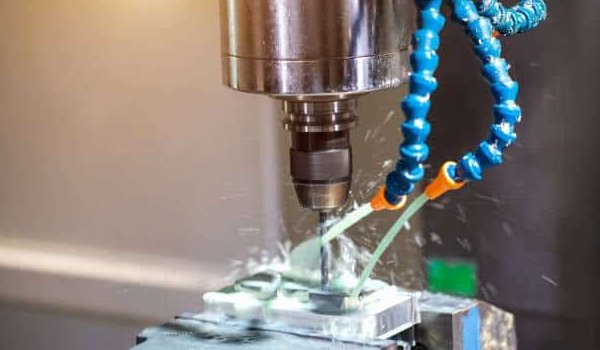
Various Coolant Delivery In CNC Machines
Different CNC machines make use of coolants with varying properties and pressure. Hence, choosing your CNC machine’s ideal coolant delivery mechanism is essential. Failure to choose the appropriate amount can cause quick exhaustion of the workshop’s resources, while the wrong pressure can damage the workpiece or the CNC cutting tools. Here are some of the common types of coolant delivery in CNC machines:
Mist Cooling Mechanism
This coolant delivery method uses a low pressure suitable for operations where heat and chip removal is not a primary concern. As such, mist cooling doesn’t subject the tool and the workpiece to additional stresses since high pressure is not applied.
Air Cooling Mechanism
The air cooling technique is not ideal for lubricity purposes but helps to reduce heat and extract chips. Air cooling delivery is less effective because it doesn’t contain oil or water-based coolant.
Moreover, the air cooling mechanism is ideal for direct contact with a workpiece when dealing with more sensitive materials. However, it is suitable for plastic materials susceptible to thermal shock or rapid expansion because direct coolant often leads to contraction in the part.
Minimum Quality Lubricant (MQL) Mechanism
The priority of each CNC shop is to achieve a competitive edge by improving workshop efficiency, increasing production, and reducing costs. As a result, CNC shops often resort to MQL due to its environmental benefits.
MQL mechanism reduces cost and material wastage by using the required amount of coolant. They are usually in a very fine mist or aerosol form, providing adequate coolant to execute a defined operation effectively.
High Pressure Mechanism
High-pressure CNC machine coolant delivery uses pressure greater than 1,000 psi to remove the chip during machining operations. This method is ideal for extracting and draining chips as it blows the chip away from the material.
The pressure used in this method may damage a micro-diameter tool even though it can cool the part quickly and effectively. Hence, this method is compatible with CNC drilling or deep cavity operations and easily transported using the coolant or built-in coolant tank.
Types Of CNC Machining Coolants
Machining coolants are in four major categories with their respective formulations. However, it would help to choose a coolant based on its efficiency and comprehensive performance, considering the material and machining process involved. Below are the common types of machine coolant.
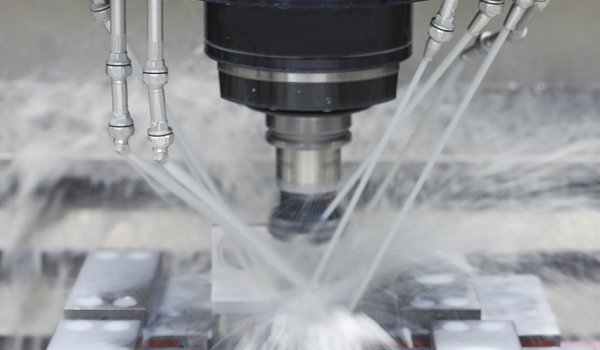
Synthetic Fluids
These coolants are the cleanest because they do not contain petroleum or mineral oil. Synthetic fluids comprise rust inhibitors and chemical lubricants that break down in water. These fluids are mixed with water to produce a metalworking fluid. Therefore, these CNC coolants possess high cooling capacity, corrosion prevention, easy maintenance, and lubricity.
Moreover, synthetic fluids are primarily employed in high-heat, high-velocity machining processes like surface grinding because of their excellent cooling capacity. Heavy-duty synthetic fluids are ideal for handling several machining operations.
Synthetics are categorized as simple and complex or emulsifiable synthetics depending on their composition. Simple synthetics or true solutions are commonly used for light-duty grinding. On the other hand, complex synthetic concentrates contain synthetic fluids suitable for moderate to heavy-duty machining procedures. More importantly, complex synthetic lubricants allow high speeds and feed in machining operations.
Pros
- Synthetic fluids exhibit high microbial control and excellent resistance to rancidity.
- These lubricants provide excellent resistance to corrosion and high cooling capability.
- They offer greater stability after mixing with water.
- Synthetics allow easy maintenance because they are clean and suitable for various machining operations.
Cons
- Machine fluids, such as lubricating oils, can contaminate synthetic fluids easily. Hence, you have to manage and maintain these fluids effectively.
- Synthetics generate fine mists or foam due to moderate to high agitation conditions, even though they are less vulnerable to issues related to oil-based fluids.
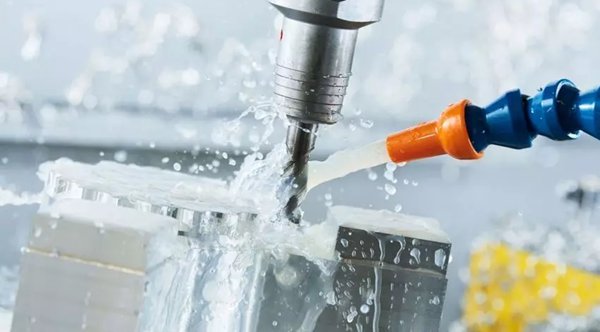
Semi-Synthetic Fluids
Semi-synthetics are a hybrid of synthetics (polymer) and soluble oils. These fluids contain about 2-30% of mineral or petroleum oil in a water-dilatable concentration. The remaining percentage of a semi-synthetic fluid consists of water and emulsifiers. Other elements in the concentrate include biocide additives, wetting agents, and corrosion inhibitors. They are commonly referred to as performed chemical emulsions because water is its primary ingredient and emulsifies with water during the concentrate’s production.
These semi-synthetic fluids are usually translucent. However, their properties can vary from slightly translucent to opaque. Additionally, many of these semi-synthetics have good heat sensitivity. Hence, semi-synthetic oil molecules surround the cutting tool, ensuring better lubricity.
Pros
- They are excellent lubricants for moderate to heavy-duty applications.
- Semi-synthetic fluids allow cutting at faster feed rates and higher speeds due to their remarkable wetting and cooling properties.
- These fluids possess low viscosity, allowing better settling and cleaning properties.
Cons
- Water hardness impairs the stability of semi-synthetic fluids causing hard water scum deposits.
- These fluids foam easily because their cleaning additives provide less lubrication than soluble oils.
Straight Oil
These oils are obtained from petroleum, mineral oil, animal, and other elements like compounds, vegetables, and fats. These straight oils sometimes contain other ingredients, such as phosphorus, sulfur, and chlorine additives. Straight oils are usually insoluble in water and provide the best lubrication, rust prevention, better sump life, and easy maintenance.
Since bacteria will only thrive in fluids with water content, straight oils do not sour. These oils lessen the force produced as the cutting tool cuts the material, making clean cuts to ensure a smooth surface finish on the workpiece.
Pros
- Straight oil offers good lubricity and reduces friction in machining operations.
- They ensure excellent finishes and minimize tool wear and tear.
- These oils are often affordable and have high compatibility with several materials like bronze, steel, and iron, commonly used in machinery and equipment.
Cons
- Straight oils have poor cooling performance.
- They usually require higher maintenance and oil changes due to their high degradation properties.
- These oils are not ideal for specific high-performance applications.
- Straight oils exhibit adverse environmental impact if not properly disposed of.
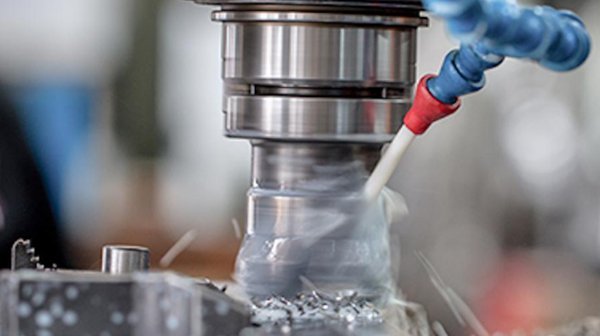
Soluble Oils
Soluble oils, also known as emulsions or water-soluble oils, are excellent coolant choices for general machining purposes and are commonly used amongst water-soluble cutting fluids. Water-soluble oils often create emulsions when mixed with water. The result of the mixture comprises the base mineral oil and the emulsion to create metalworking fluid. It performs well in diluted form and offers excellent lubricity and heat transfer performance.
Soluble oils are cheap and commonly used in the metalworking industry. They comprise 60-90% petroleum, emulsifiers, or mineral oil and adhere to the workpiece during machining. It is ideal for lubrication and offers excellent rust resistance when mixed with a specific amount of rust inhibitor.
Pros
- These oils facilitate better cooling and lubrication because of the water and oil blend.
- Soluble oils are multipurpose and are ideal for light and medium-duty operations, including various ferrous and nonferrous applications.
- You may accompany operations such as tapping and broaching handled with straight oils using heavy-duty soluble oils.
Cons
- The coolant tank encourages microbial growth of bacteria and fungi when improperly maintained.
- Oil in the mixture results in rust control problems, evaporation losses, and tramp oil contamination.
Understanding CNC Machine Coolant Concentration
Applying the wrong coolant concentration in your CNC machine can lead to several complications. Therefore, it is essential to understand how to use the appropriate CNC machine coolant ratio to achieve the best results. Certain risks are associated with applying coolant concentration lower than the minimum requirements of the CNC machine. These include:
- Microbial growth
- Faster wear-out of cutting tools
- Corrosions of parts and machinery
On the other hand, risks caused by excessive coolant concentration include:
- Foaming
- Toxicity
- Concentrated wastage
- Reduced heat conduction
- Poor lubrication
- Discoloration of machinery and machined parts
- Degradation of tools due to residue build-up
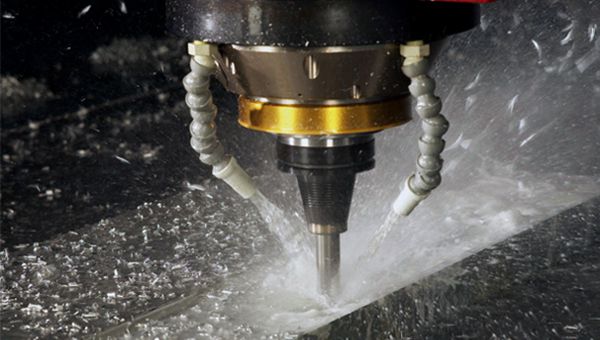
CNC Coolant Concentration Chart
Below is a coolant concentration chart containing variations in the CNC coolant concentration levels:
| Material | Milling | Turning | Drilling | Tapping |
| Copper | Soluble oil | Soluble oil | Soluble oil | Soluble oil |
| Aluminum | Mineral oil or soluble oil (with 96% water) | Mineral oil with soluble oil (or) 10% fat | Soluble oil (with 70-90% water) | Mineral oil mixed with 25% based oil |
| Bronze | Soluble oil | Soluble oil | Soluble oil | Mineral oil with 30% lard |
| Low Carbon and Tool Steel | Soluble oil | 75% mineral with and 25% lard oil | Soluble oil | Mineral oil with 25%-40% lard oil |
| Malleable Iron | Soluble oil | Soluble oil | Soluble oil | Soluble oil |
| Alloy Steels | 90% mineral oil with 10% lard oil | 75% mineral oil with 25% sulfur base oil | Soluble oil | 70% mineral oil with 30% lard oil |
| Brass | Soluble oil (with 96% water content) | Mineral oil with 10% fat | Soluble oil | Mineral oil with 10% – 20% lard oil |
| Cast Iron | Dry | Dry | Dry | 25% lard oil with 80% mineral oil or dry |
Water-Based Cutting Fluids Vs. High-Pressure CNC Coolants
Water-based cutting fluids and high-pressure CNC machine coolants are common in metalworking processes. These fluids are efficient in lubricating cutting tools and materials.
Water-based fluids have excellent heat dissipation properties and lubricity. They are generally environmental-friendly and cost-effective alternatives to high-pressure machine coolants. However, water-based coolants are vulnerable to bacterial growth and can encourage corrosion in certain metals.
Meanwhile, it would help to invest in a system that can increase speeds and feeds, improve tool life, and prevent problems with chip control if your machine works with high-pressure CNC coolants. As a result, high-pressure CNC coolant boosts productivity significantly. You could experience above 1,000 psi pressures vital for tapping and deep-hole drilling operations.
However, high-pressure CNC coolants are costly and require high maintenance to ensure optimal functionality. Additionally, these systems require skills to ensure safe and efficient operation.
Conclusion
Coolants for CNC machines help achieve optimal efficiency in a CNC shop. These coolants help reduce heat build-up, lubricate the cutting tool, and prevent discoloration and failure in machining processes such as CNC milling, turning, or drilling.
Do not hesitate to contact us at WayKen whenever you need the help of professionals in determining the ideal lubricant type and pressure for your CNC machines. We are a one-stop CNC shop for all your manufacturing needs, we offer you reliable and professional CNC machining services.
FAQs
When is the right time to change a CNC machine coolant?
Various factors often influence the interval you need to change your machine coolant. You must consider the machined material, coolant type, and operating condition of the CNC machine. However, most CNC machine makers recommend every 6-12 months as a general rule of thumb.
How do I kill bacteria in CNC machining coolant?
You can prevent or stop bacterial growth in coolant for CNC machines by injecting ozone directly into the coolant. It kills viruses, yield, bacteria, or molds and eliminates coolant sump odors.
What causes foaming in a CNC coolant?
The lack of minerals in the water supply is a primary cause of foaming in coolants. However, checking the water’s hardness using Hardness Testing Sticks is advisable


